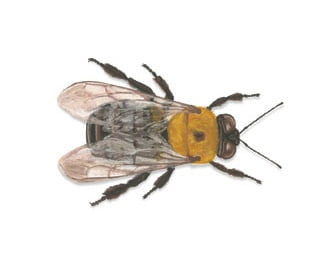Carpenter bees (Xylocopa spp. — 8 species) are the largest native bees in Fiji. These are WILD bees, and not kept by beekeepers.
Appearance
- Carpenter bees are the largest native bees at 15-24 mm long
- Females have a glossy black abdomen and yellow fur on the thorax
- Males are covered in yellow brown or olive fur including on the head
Life cycle and habits of carpenter bees
Lifecycle
- Tunnel into wood to lay eggs
- Life cycle from egg – larva – pupa – adult takes approximately seven weeks
- Larva is large and noisy
- New adults emerge from the nest late August
Habits
- Active — late-spring to mid-October
- Nesting — they make tunnels in bare, untreated wood to lay their eggs
- Old nests are used year after year
- Location — around homes nests can be found in eaves, window trims, fascia boards, siding, decks and outdoor furniture
- Feeding — feed on pollen and nectar; pollen is stored in the tunnels for over-wintering
- Do not sting unless provoked

